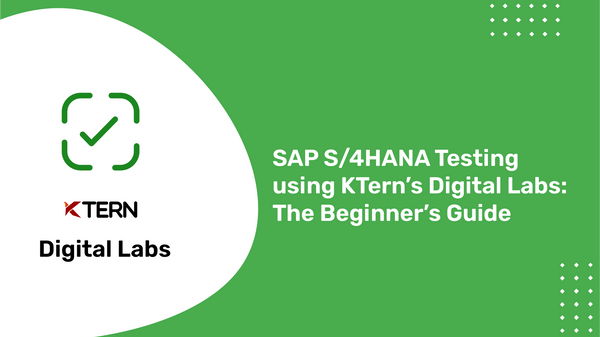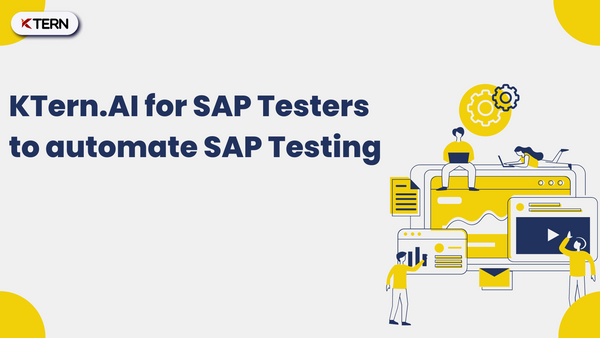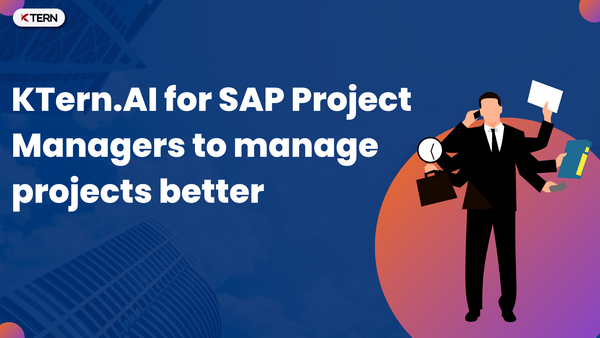SAP S/4HANA Test Lifecycle - Faster, Better, Smarter with KTern.AI
In this article, we'll be discussing the test lifecycle for SAP S/4HANA. We'll go over what it is, what it's used for, and how it can help you speed up your testing process. We'll also touch on some of the benefits of using the test lifecycle for SAP S/4HANA.
By the end of this article, you should have a good understanding of the test lifecycle for SAP S/4HANA and how it can help you streamline your testing process.
Table of Contents
- Overview of SAP S/4HANA
- SAP S/4HANA Test lifecycle
- Test lifecycle Management
- Test Planning
- Test Preparation and Execution
- Test Validation
- KTern.AI Digital Labs – An Intro
- Test suite Dashboard and Test case Wizard
- Improving - Managing - Automating
- Intelligent and Automated approach to testing
- Tips for making the Test lifecycle for SAP S/4HANA
- Advantages of Test lifecycle
- Best practices for improving the test lifecycle
- Challenges in SAP Testing
- What sets this one apart from others?
- Conclusion
Overview of SAP S/4HANA
SAP S/4HANA is a business software suite that helps businesses run more efficiently.
It offers a variety of features, including financial accounting, enterprise resource planning, and customer relationship management. SAP S/4HANA is built on the SAP HANA platform, which uses in-memory database technology to deliver faster performance.
SAP S/4HANA Test lifecycle
- S/4HANA testing involves confirming the software's functionality with the goal of determining whether the ERP system complies with the given requirements.
- Before the project deployment Go-Live, testing is essentially a quality assurance process that makes sure SAP S/4HANA is operating correctly. Additionally, testing is not just done during the project's implementation and go-live phases. A modern ERP with frequent upgrades and new releases is SAP S/4HANA.
- Because testing is required for every upgrade, customers must understand that testing for SAP S/4HANA is a continuous, never-ending activity.
Test Lifecycle Management
The test lifecycle consists of three phases as per the SAP Activate Methodology,
- Test Planning
- Test Preparation and Execution
- Test Validation

Test Lifecycle for SAP S/4HANA Process
- Define the scope of your testing project
- Identify the key business processes that need to be tested
- Develop a testing strategy that includes both manual and automated testing
- Create test cases that cover all aspects of the business processes
- Execute the test cases and track the results
- Analyze the results and identify any areas that need improvement
- Repeat the process until all business processes are successfully tested
Test Planning
The most crucial work is test planning, which makes sure that a baseline plan includes a list of tasks and milestones so that progress can be monitored.

Creating a Test Plan
In the Test Catalog, select the "Create New" button.
You will be given the choices of Test Plan, Test Scenario, and Test Case when you click that button. Pick Test Plan.

As illustrated below, the 'Create Test Plan' drawer will now be opened.
Test Plan: Type the name of the test plan. This field is required.
Description: Put a brief summary of the test plan here. This field is required.
Acceptance Criteria: Enter the test plan's acceptance criteria in the box below. This field is required.
Select Priority
In order to create a new Test Plan, click the Submit button.
Test Preparation and Execution
Preparation
The following actions must be taken within each scope of a solution that has been implemented:
- Extend test cases for best practises
- Create test cases for the delta process
- Finalize integration and user-acceptance test cases and plan
- Build the approval procedures.
- Prepare for tool adaptation and training on delta user acceptance tests.
- Testing can start once the tests have been planned and the test data has been made available on the test systems.
Execution
- The test's steps are listed in the execution log along with whether they passed or failed, and if they did, why.
- It keeps track of the steps taken and the elements that were affected. Regardless of whether they are a part of the primary parent test or a test as a step, all stages are included in one sequence.

Creating Test Execution Log
- Select the "Test lab" tab in the Test Case Wizard.
- Click "Add new Test Lab Item" in the test lab. You will be given the choice between the Test Execution Log and Test Script when you select that button. Opt for Test Execution Log.
- The "Create Test Log" drawer will open when the Test Execution Log option is clicked.

- Execution title: Type the title of the execution. This field is required.
- Actual Environment: Select the location where the testing took place. This field is not required.
- Select the test script that will be used for testing. This field is required.
Defect:

- Press the "Add new defect" button.
- the name of the defect. This field is required.
- Decide who you want to allocate the task to. This field is required.
- To complete defect resolution, select the Start date and End date options.
- To produce a Test Execution Log, click the Submit button.
Test Validation
The steps involved in the Test Validation Phase are:

- Prepare and document User Acceptance Test Case
- Execute User Acceptance Test Case
- Perform defect resolution for User Acceptance Test
- Obtain User Acceptance Test Sign Off
KTern.AI Digital Labs – An Intro
- The project management tool, Digital Projects hub, is closely connected with Digital Labs of KTern.
- On one side, the testers would typically be testing the different test cases, and the governance would be carried out using emails, chat, or any other project management tool.

- All relevant stakeholders found the process to be laborious and clumsy. In order to execute, manage, and cooperate on all testing-related project activities for a S/4HANA migration or upgrade from a single location, we created Digital Labs of KTern.
- KTern adheres completely to the SAP Activate structure. As a result, KTern thoroughly analyses the entire ECC ecosystem as the first step of the Discover phase and automatically suggests test cases and test scenarios.

The following are some notable features of KTern's Digital Labs:
- Built exclusively for SAP transformation initiatives using the Activate framework from SAP
- An internal S/4HANAPEDIA rule engine that is based on AI
- Recommendations for Value, Volume, and Velocity (VVV) based auto test cases
- Executions of automated test cases and a defect database
- API-based and screen recorder-based testing that uses legible, real-time test cases without scripts
- Skills for project management that are tightly integrated
- Timeline and total project costs are reduced by 30% to 40%.
Test suite Dashboard and Test case Wizard
Test suite Dashboard - VVV Analysis
The Value, Velocity, and Volume Analysis of the business per transaction consumption is covered by the VVV Scoring Dashboard. In a system, there may be 'n' business processes.
Each transaction is automatically evaluated by KTern based on its value, volume, and velocity, and a score between 1 and 10 is given.
KTern calculates the materiality score for the business processes using the VVV scores.

The entire business value produced from the particular transaction is shown by the materiality score. The more relevant the business process, the higher the score, and vice versa.
Based on this VVV-based materiality score, KTern automatically generates test case recommendations and allocates the priority of each test case.
Test case Wizard
KTern provides the basic information on each test case in the test case wizard. It consists of the following basic information:
- The test case's place in the test plan and scenario
- The test case's related functional module
- The test case's Business Process
- Description of the test case
- Test type and priority
- The stakeholders who are involved in each test case
- References and Files Notes
- Discussion Forum

Improving - Managing - Automating
Improving the Test Lifecycle for SAP S/4HANA
The section content for "Improving the Test Lifecycle for SAP S/4HANA" should provide an overview of how to optimize the test lifecycle for SAP S/4HANA. It should discuss the different stages of the test lifecycle, and how to optimize each stage to ensure a successful transition to SAP S/4HANA.
Automating the Test Lifecycle for SAP S/4HANA
Automating the test lifecycle for SAP S/4HANA Cloud is key to ensuring a successful transition to the cloud.It offer a complete, end-to-end solution that helps you increase efficiency and quality while reducing costs.
Our solution includes tools and services for:
• Automated testing
• Continuous integration and delivery
• Test management
• Performance testing
• Security testing
• SAP
Managing the Test Lifecycle for SAP S/4HANA
This process includes the following steps:
Planning the test lifecycle, Creating the test environment, Executing the tests, Analyzing the test results, Reporting the test results, Managing the test environment
Intelligent and Automated approach to testing
- SAP S/4HANA offers a more intelligent and automated approach to testing, which can help reduce the amount of time and resources needed to ensure software quality.
- By using SAP S/4HANA, businesses can take advantage of features like in-memory computing, advanced analytics, and machine learning to help automate testing processes and improve the accuracy of results.

- The test lifecycle for SAP S/4HANA is shorter and more efficient than ever before.
- This is because SAP S/4HANA is designed to be more user-friendly and require less customization, making it easier and faster to test.
- In addition, the new release strategy for SAP S/4HANA means that new features and functionality are released more frequently, allowing for more frequent testing cycles.
Tips for making the Test lifecycle for SAP S/4HANA
1. Make sure to involve all stakeholders in the test lifecycle from the beginning.
2. Define clear objectives for the testing process and ensure everyone is on the same page.
3. Create a realistic schedule for the testing process and ensure everyone understands the timeline.
4. Make sure to allocate adequate resources for the testing process.
5. Conduct regular status meetings to ensure everyone is on track and address any issues that arise.
Advantages of Test lifecycle
SAP S/4HANA's test lifecycle offers many benefits that can help organizations streamline their testing processes. By automating the test lifecycle, organizations can reduce the amount of time and resources required to complete testing. Additionally, automating the test lifecycle can help organizations improve the quality of their testing processes by ensuring that tests are accurately conducted and that test results are properly documented.
Best practices for improving the test lifecycle
Assuming you are talking about the testing lifecycle for an SAP S/4HANA project, here are some best practices to follow:
1. Define the scope of the testing effort early on in the project. This will ensure that everyone is clear on what needs to be tested and that the right resources are allocated to the testing effort.
2. Create a detailed test plan that outlines the approach to testing, the resources required, and the schedule for execution.
Challenges in SAP Testing
The challenges might be related to:
- SAP System
- Dataset
- Environment
- Planning
- Review
- Repeatability
Challenges in SAP Testing Explained - KTern Webinar
Challenges Related to SAP System
Running SAP Tests presents a number of difficulties relating to the SAP System. It can be because intertwined processes require complicated architecture or procedures, or because the system being tested doesn't have cross-functional technological support.
Challenges Related to Dataset used
It could be difficult when there is data from the last 15 to 20 years. Dataset-related issues are brought on by both the diversity and number of data sets being more than the system can handle. It will be challenging to select a reliable dataset combination from the vast amount of data that is currently at your disposal.
Problems in SAP S/4HANA Testing
- Poor documentation of testers
- Low degree of test automation
- Maintaining test audits
- Cost-benefit analysis of testing
What sets this one apart from others?
KTern stands out because it gives us the ability to automate, manage, and monitor the testing process analysis beginning with the Discover phase.
Additionally, each test case is described in detail by KTern, and the calculation of the materiality score aids in the prioritisation of test execution.

The strong connection between Digital Labs and Digital Projects is yet another distinguishing feature of KTern.
Projects involving digital transformation rely on more than just data and process flows. The active engagement of stakeholders is one of the crucial elements for any digital transformation's success. The S/4HANA conversion project, which is at the centre of your digital organisation, is no different. For all parties participating in the project, KTern offers a completely immersive experience in this regard.
Conclusion
At-last, in this blog you have a better understanding of the test lifecycle for SAP S/4HANA and how it can make your testing process more efficient.
If you want to know more about the features of KTern.AI, Get Started with us.
If you have any queries, feel free to Contact us.




